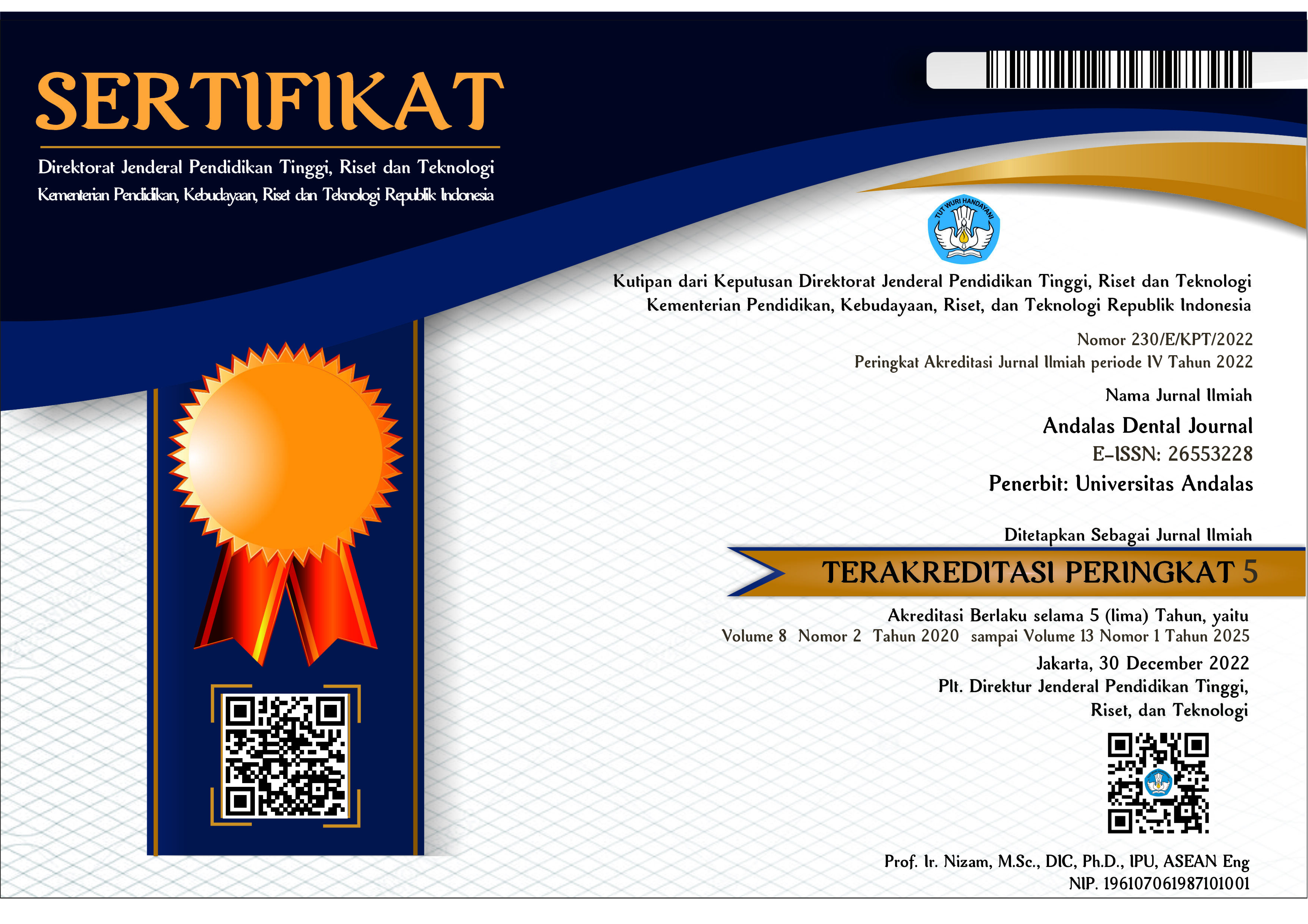DIFFERENCES IN EFFECTIVENESS TOOTHPASTE GEL FORMULATION WITH PASTE IN MAINTAINING NORMAL SALIVARY PH
Abstract
Saliva is oral fluids consisted of mixture of secretions from major and minor salivary glands. Salivary pH ranges from 5.6 to 7.0 with average in 6.7. Teeth brushing could change salivary pH. Toothpaste which distribute among our society nowadays is either gel or paste contain xylitol or sorbitol. Xylitol and sorbitol are able to stimulate the secretion of saliva therefore increase buffering capacity and pH of saliva. This research is an experiment with pre-test post-test study design. This research used 36 samples. The measurement of the pH of saliva was performed five times: before brushing, 5, 10, 30 and 60 minutes after brushing with toothpaste. Result showed significant differences in before brushing with 5 minutes after brushing, and 5 minutes with 10 minutes after brushing. While in 10 minutes with 30 minutes after brushing and 60 minutes with 30 minutes after brushing there was no significant differences. The average pH of saliva by gel formulation is more fluctuating than pH saliva by paste formulation which tends to decline as time changes in normal circumstances and more stable to maintain normal salivary pH. The conclusion of this research is toothpaste with paste formulation is more stable in maintaining normal pH of saliva compared to toothpaste with gel formulation
Keywords : salivary pH, toothpaste gel formulation, toothpaste paste formulation
References
2. Poucher, J. 2000. Poucher’s Perfumes, Cosmetics and Soaps. Edisi Kesepuluh.London: Kluwer Academic Publisher. Hal. 206, 210.
3. Y. Herdiyanti, I.S Sasmita. 2010. Pengggunaan Fluor dalam Kedokteran Gigi. FKG UNPAD.
4. Sari, Ni Yoman Gemini. 2011.Permen Karet Xylitol yang Dikunyah 5 Menit Meningkatkan dan Mempertahakan pH Saliva Perokok Selama 3 Jam. Denpasar: Universitas Udayana.
5. Mitsui, T. Phd., 1997. New cosmetics science, Elsevier: Amsterdam.
6. Teki K, Bhat R. 2013. Estimation of the Component in Oral Care products Available in Indian Market – Part II : Toothpaste. Oral Care R & D Unit, Kemwell Biopharma Private Limited, Bangalore, India. International Journal of Pharmaceutical and Chemical Sciences; 2013: 2 (2), 705-712.
7. Ligtenberg AJM, Brand HS, Bots GP, Amerongen AVN. 2006. The Effect of Toothbrushing on Secretion Rate, pH and Buffering Capacity of Saliva. Int Dent Hygiene: 4 : 104-105.
8. Setia R , Handajani J. 2010. Mengkonsumsi minuman beralkohol dapat menurunkan derajat keasaman dan volume saliva. DENTIKA: 15(1), 16, 18.
9. Handajani J, Rini MP. 2010. Pemakaian kontrasepsi pil dan suntik menaikkan pH dan volume saliva. DENTIKA: 15(1), 1.
10. Almeida PV, Gregio AM, Machado MAN, Lima AAS, Azevedo LR. 2008. Saliva Composition and Function. J Contemp Dent Pract: 9(3), 2-5.
11. Nutt JB, Susan EB. 2013. Effect Of Toothpaste Formulations On The Number Of Viable Bacteria Left On Toothbrushes Following Routine Brushing. Rivier Acadenic Journal: 9(1), 2.
12. Harry.R.G. 1973. Harry’s cosmetology, 6th edition, leonard hill books. New York.
13. George M. Howard. 1974. Perfume, cosmetics and soaps, Vol.III, eight edition, Chapman and Hall, London.
14. Lieberman, H. A., Rieger, M. M., dan Banker, G. S., 1996. Pharmaceutical Dosage Forms: Dispers System, Vol. 2, Second Edition, 397, 400-401, Mariel Dekker, Inc., New York Nair ASU, Rooban T, Kannan R. Saliva and dental practice. J NTR Univ Health Sci; 2012: 1(2), 73.
15. Hidayani TA, Handajani J. 2010. Efek Merokok Terhadap Status Ph Dan Volume Saliva Pada Laki-Laki Usia Dewasa dan Usia Lanjut. DENTIKA; 2010: 15(2), 146,148.
16. Maldupa I, Anda B, Inga R, Anna M. 2012. Evidence Base Toothpaste Classification, According To Certain Characteristics Of Their Chemical Compotition.Baltic Dental and Maxillofacial Journal; 2012: 14(1), 13, 16-9.
17. Nigam AG, Jaiswal JN, Murthy RC, Pandey RK. 2009. Estimation Of Fluoride Release From Various Dental Materials In Different Media-An In Vitro Study. J Clin Pediatr Dent; 2009: 2(1), 1.
18. Tschoppe P, Hendrik ML. Effect of regular and highly fluoridated toothpastes in combination with saliva substitutes on artificial enamel caries lesions differing in mineral content. Archives of oral biology. Available from http://www.sdclucknow.com/Journal2012/93. Accessed December 6, 2015.
19. Santi C, Sri R, Cut RR. 2010. Pengaruh Bahan Antikaries Bebrapa Tanaman Herbal Yang Dikombinasikan Dengan Pasta Gigi Yang Mengandung Fluoride Terhadap Pertumbuhan Streptococcus Mutans Secara In Vitro. DENTIKA; 2010: 15(2), 136.
20. Talha WM, Mana E, Ola MO, Somaiya AE. 2013. The Effect Of Miswak And Fluoride Toothpastes On Dental Plaque, A Comparative Clinical And Microbiology Study. Nature and Science; 2013: 11(9), 3.
21. Agtini Md, Sintawati, Tjahja I. 2005. Fluor dan Kesehatan Gigi. Media Litbang Kesehatan; 2005: 15(2), 28.
22. Dabrowska E, Letko M, Roszkowska JW, Letko R, Jamiolkowski J. 2005. Effect Of Fluoride Preparations On The Activity Of Human Salivary Cathepsin C. RoczAkad Med Bialymst; 2005: 50, 162.
23. Bardow A, Lagerloff, Nauntofte B, Tenovuo J. 2008. The role of saliva. Dental Caries The disease and Its Clinical Management. 2nd ed. Australia: Blackwell munksgaard Ltd.; 2008. pp. 203.
24. Limeback H, Colin R. Fluoride therapy. 2012 Comprehensive Preventive Dentistry. USA: John Wiley and Sons Ltd.; 2012. pp. 257-8.
25. Kidd, E.A.M., Bechal, S.J. 1992. Dasar-Dasar Karies Penyakit dan Penanggulanganya. Alih Bahasa : Narlan Sumawinata dan Safrida Faruk.
EGC. Jakarta. Hal.2,65-67.
26. Amerongen, A.V.N. 1991. Ludah dan Kelenjar Ludah. Arti Bagi Kesehatan Gigi. Alih Bahasa : Prof.drg.Rafiah Abyono. Ed-1.UGM. Yogyakarta. Hal.2,3,23,36,37.
27. Kelley, L.L., Petersen, C. M. 2007. Sectional Anatomy for Imaging Professionals. Second Edition. Mosby. Elsevier. USA. Hal.242.
28. Guyton, A.C., Hall, J.E. 2008. Buku Ajar Fisiologi Kedokteran. Alih Bahasa : Irawati dll. Cetakan-1. EGC. Jakarta. Hal.835-836.
29. Sherwood, L. 2001. Fisologi Manusia. Alih Bahasa: Brahm U. Pendit. Ed-2. EGC. Jakarta. Hal.545-548.
30. Snell, R. S. 2004. Clinical Anatomy . Ed-7. Lippicot Williams & Wilkins. USA. Hal.773-788.
31. Snell, R.S. 1997. Anatomi Klinik. Untuk Mahasiswa Kedokteran. Alih Bahasa : dr. Jan Tambayong. Bag-3. Ed-3. EGC. Jakarta. Hal.10.
32. Marieb, E.,N., 2004, Human Anatomy & Physilogy. Sixth Adition. Pearson Benjamin Cummings. Hal.890-891.
33. Martin, T. 2008. The Effects of Smoking on Human Health Smoking Effect. [cited 2010 mar. 17] Available from: http:// quitsmoking.about.com.
34. Roukema, P.A.M. 1993. Ilmu Kedokteran Gigi Pencegahan. Penerjemah: Sutatmi Suryo. Cetakan I. UGM. Yogyakarta. Hal.114-123.
35. Tumilasci, O.R., Cardoso, E.M.L., Contreras, L.N., Belforte, B., Arregger, A.L., Ostuni, M.A. 2006. Standardization of Simple Method to Study Whole Saliva: Clinical Use in Difefrent Pathologies. Acta Odontol Latinoam; 19 (2): 47-51.
36. University of Newcastle Dental School. 2009. Bite-Sized Tutorials: Salivary Buffering, Bicarbonate & pH. Dirujuk 9 Februari, 2016 dari http://ncl.ac.uk/dental/oralbiol/oralenv/tutorials/bicarbonate.htm















